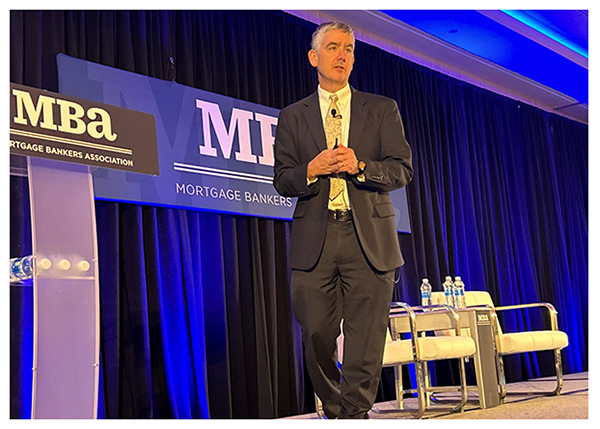
MBA’s Michael Fratantoni Provides Market Outlook, Notes ‘It’s Not 2008’

(Michael Fratantoni speaks at the conference, via Anneliese Mahoney)
WASHINGTON–The industry has plentiful challenges, but is in a very different spot than during the Great Recession, said Michael Fratantoni, Mortgage Bankers Association Chief Economist and Senior Vice President of Research and Industry Technology, here at the National Advocacy Conference.
Applications are trailing a bit below 2023 so far. “But when I talk to lenders across the country, in different business models and different sizes, they say ‘yeah our application flow is not what we’d want it to be. But we have a lot of customers coming in getting pre-qualified.’ So the demand is there,” Fratantoni said. “And that makes sense to me.”
Fratantoni pointed out that there are about 50 million people in the U.S. between 30-40–right around prime buying age.
“It’s a lot of latent demand–folks that just can’t find properties,” he said.
Fratantoni pointed to the oft-cited “lock-in effect” as playing a big role on the supply end.
Fratantoni was careful to note: this is not like the market we saw in 2008. This is not a situation where credit has been overextended, but one where the underlying demand is demographically driven, combined with a structurally undersupplied market.
But, some good news is that “builders have responded to this lack of existing inventory,” Fratantoni said. “We’re expecting about a 13% gain in 2024 in new home sales compared to 2023.”
“We’re leaning into the new home market and new construction much more than we typically do,” he continued. “Typically, you’d expect maybe 10% of homes on the market to be new construction. We’re in a world right now where about a third of homes on the market are new construction.”
In terms of pricing, he predicted–as rates likely come down–a moderation in home price growth during the next few years, as there are additional suppliers and builders. That means more like 3-4% gains in home prices compared with 6% last year. However, he cautioned there’s a lot of variables in play that could affect that outlook in either direction.
And, factors such as rising home insurance prices are affecting affordability too.
Some of the other recent trends are staying consistent. For one, “this is not a refinance market,” Fratantoni said, noting refinance volume is down significantly from the levels in 2020 and 2021. Despite improved interest rates from various points last year, refinance activity isn’t rebounding.
However, Fratantoni predicted a potential uptick in cash-out refinances–Americans have about $32 trillion in home equity, and a lot of consumer debt.
“You look at our forecast–we are expecting some growth these next couple of years,” Fratantoni said about the industry overall. “But it’s still going to be a lean environment for the mortgage industry.”
However, Fratantoni isn’t predicting a spike in delinquencies and foreclosures, like during the Great Recession. “We’re just not seeing that,” he said.
